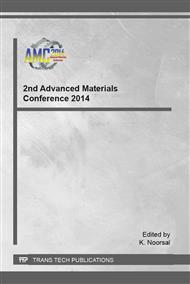[1]
E.D.J. Sloan, C. Koh, Clathrate hydrate of natural gases, 3rd ed., CRC Press, Boca Raton, FL, (2008).
Google Scholar
[2]
J.P. Osegovic, H.J. P, S.R. Tatro, M.D. Max, On-site freshwater production for offshore facilities, Proceedings in: SPE International Symposium on Oilfield Chemistry 2007. (2007) 431-433.
DOI: 10.2118/106197-ms
Google Scholar
[3]
A. Delahaye, L. Fournaison, S. Marinhas, I. Chatti, J.P. Petitet, D. Dalmazzone, W. Fürst, Effect of THF on equilibrium pressure and dissociation enthalpy of CO2 hydrates applied to secondary refrigeration, Industrial and Engineering Chemistry Research. 45 (2006).
DOI: 10.1021/ie050356p
Google Scholar
[4]
I. Chatti, A. Delahaye, L. Fournaison, J.P. Petitet, Benefits and drawbacks of clathrate hydrates: A review of their areas of interest, Energy Conversion and Management. 46 (2005) 1333-1343.
DOI: 10.1016/j.enconman.2004.06.032
Google Scholar
[5]
Y. Zhong, R.E. Rogers, Surfactant effects on gas hydrate formation, Chem. Eng. Sci. 55 (2000) 4175-4187.
DOI: 10.1016/s0009-2509(00)00072-5
Google Scholar
[6]
A.H. Mohammadi, B. Tohidi, R.W. Burgass, Equilibrium data and thermodynamic modeling of nitrogen, oxygen, and air clathrate hydrates, Chem. Eng. Data. 48 (2003) 612-616.
DOI: 10.1021/je025608x
Google Scholar
[7]
Q. Nasir, K.M. Sabil, K. Nasrifar, Measurement and phase behaviour modeling (Dew point + bubble point) of CO2 rich gas mixture, Journal of Applied Sciences. 14 (2014) 1061-1066.
DOI: 10.3923/jas.2014.1061.1066
Google Scholar
[8]
K.M. Sabil, Q. Nasir, B. Partoon, A.A. Seman, Measurement of H–LW–V and dissociation enthalpy of carbon dioxide rich synthetic natural gas mixtures, Journal of Chemical & Engineering Data. 59 (2014) 3502-3509.
DOI: 10.1021/je500453j
Google Scholar
[9]
B. Tohidi, A. Danesh, A.C. Todd, R.W. Burgass, K.K. Ostergaard, Equilibrium data and thermodynamic modelling of cyclopentane and neopentane hydrates, Fluid Phase Equilib. 138 (1997) 241-250.
DOI: 10.1016/s0378-3812(97)00164-7
Google Scholar
[10]
D.B. Robinson, Hydrates in the propane, carbon dioxide and water system, J. Can. Petro. Tech. 10 (1) (1971) 10-35.
Google Scholar
[11]
A. H. Mohammadi, R. Anderson, B. Tohidi, Carbon monoxide clathrate hydrates: experimental equilibrium data and thermodynamic modeling, AIChE J. 51 (2005) 2833.
DOI: 10.1002/aic.10526
Google Scholar
[12]
A. Hachikubo, Miyamoto, Atsushi, Hyakutake, Kinji, K. Abe, H. Shoji, Phase Equilibrium Studies on Gas Hydrates Formed from Various Guest Molecules and Powder Ice. In: The Fourth International Conference on Gas Hydrates, Yokohama, Japan, 2002, pp.357-360.
Google Scholar
[13]
K.M.W. Sabil, G.J. Peters, Phase equilibria of mixed carbon dioxide and tetrahydrofuran hydrates in sodium chloride aqueous solutions, Fluid Phase Equilibria. 284 (2009) 38-43.
DOI: 10.1016/j.fluid.2009.06.006
Google Scholar
[14]
H.J. Shin Lee Y.J. Im, Y.H. Han, K.W. Lee, J.W. Lee,Y. Lee, J.D. Jang, W.Y. Yoon, Thermodynamic stability, spectroscopic identification and cage occupation of binary CO2 clathrate hydrates, Chem. Eng. Sci, 64 (2009) 5125-5130.
DOI: 10.1016/j.ces.2009.08.019
Google Scholar
[15]
J. Tang, D. Zeng, C. Wang, Y. Chen, L. He, N. Cai, Study on the infulence of SDS and THF on hydrate-based gas separation performance, Chem Engineering Research and Design. 91 (2013) 1777-1782.
DOI: 10.1016/j.cherd.2013.03.013
Google Scholar


